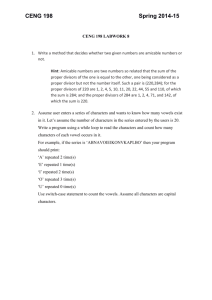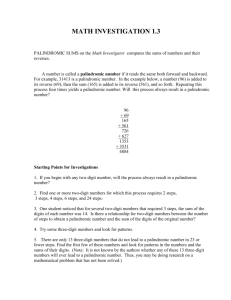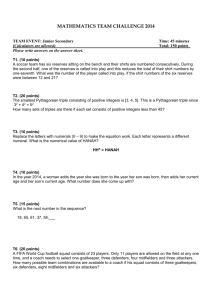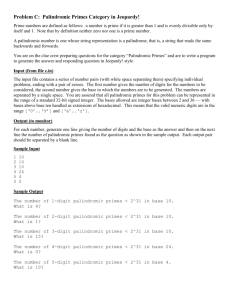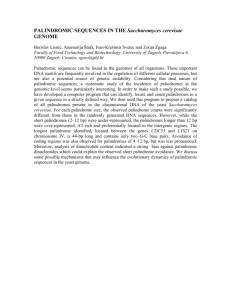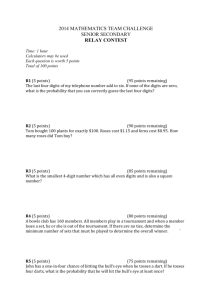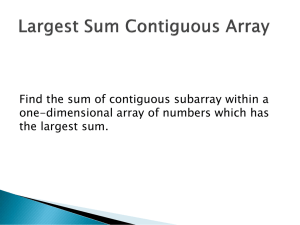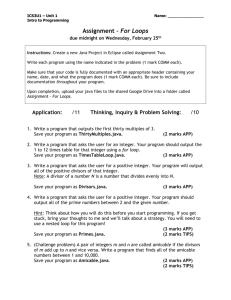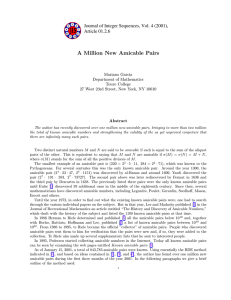different types of natural numbers
advertisement
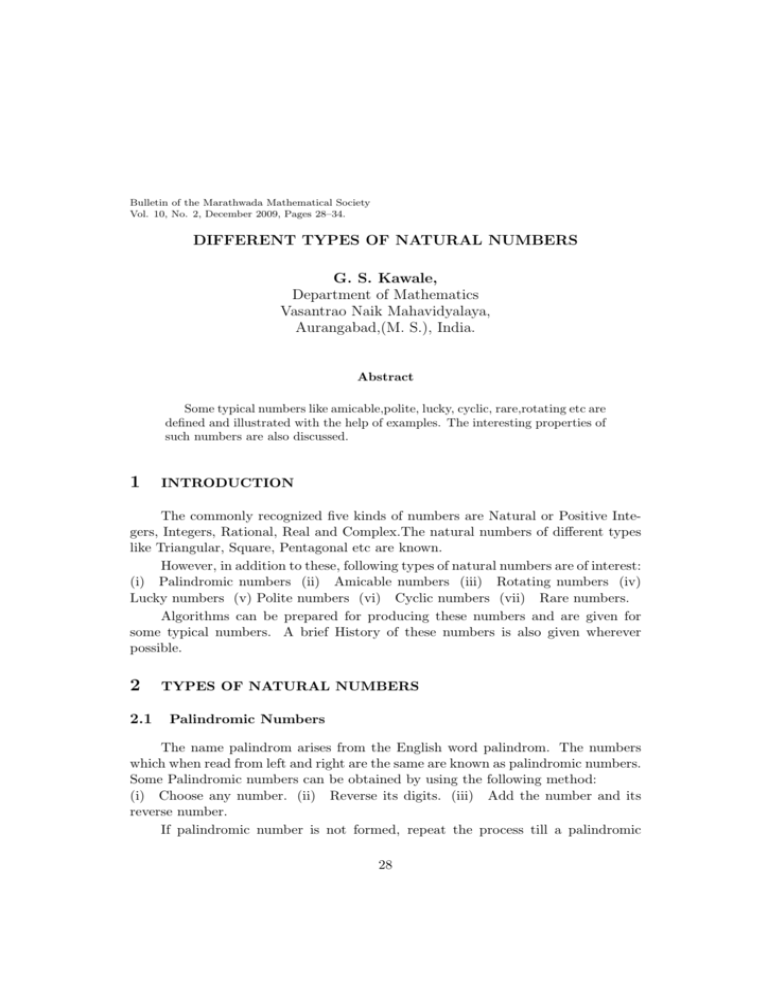
Bulletin of the Marathwada Mathematical Society Vol. 10, No. 2, December 2009, Pages 28–34. DIFFERENT TYPES OF NATURAL NUMBERS G. S. Kawale, Department of Mathematics Vasantrao Naik Mahavidyalaya, Aurangabad,(M. S.), India. Abstract Some typical numbers like amicable,polite, lucky, cyclic, rare,rotating etc are defined and illustrated with the help of examples. The interesting properties of such numbers are also discussed. 1 INTRODUCTION The commonly recognized five kinds of numbers are Natural or Positive Integers, Integers, Rational, Real and Complex.The natural numbers of different types like Triangular, Square, Pentagonal etc are known. However, in addition to these, following types of natural numbers are of interest: (i) Palindromic numbers (ii) Amicable numbers (iii) Rotating numbers (iv) Lucky numbers (v) Polite numbers (vi) Cyclic numbers (vii) Rare numbers. Algorithms can be prepared for producing these numbers and are given for some typical numbers. A brief History of these numbers is also given wherever possible. 2 2.1 TYPES OF NATURAL NUMBERS Palindromic Numbers The name palindrom arises from the English word palindrom. The numbers which when read from left and right are the same are known as palindromic numbers. Some Palindromic numbers can be obtained by using the following method: (i) Choose any number. (ii) Reverse its digits. (iii) Add the number and its reverse number. If palindromic number is not formed, repeat the process till a palindromic 28 DIFFERENT TYPES OF NATURAL NUMBERS 29 number is obtained. Example 87 + 78 = 165 165 + 561 = 726 726 + 627 = 1353 1353 + 3531 = 4884. 4884 is a palindromic number. 196 is the only number not giving palindromic number in 10,000 steps. The mathematician Leiland started from 196 and repeated the above process 50,000 times but he could not reach a palindromic number.The mathematician Anderton repeated the process 70,928 times starting from 196 but a palindromic number could not be obtained. In one lac steps , the number 5996 does not give a palindromic number. Number 22 and its square 484 are both palindromic. Similarly some powers of 11 are palindromic. The sum and product of two palindromic numbers need not be always a palindromic number. Some palindromic numbers are prime numbers. Foe example, 101, 131, 151, 181, 313, 353, 727, 757, 797, 919, 79997, 91019, 93139, 93739, 94049 etc are prime and palindromic. 2.2 Amicable Numbers Two integers x and y are said to be amicable if each of them can be expressed as the sum of all the divisors of the other, except that number. Foe example 284 and 220 are amicable numbers because the sum of the divisors of 220 is 1 + 2 + 4 + 5 + 10 + 11 + 20 + 22 + 44 + 55 + 110 = 284 and the sum of the divisors of 284 is 1 + 2 + 4 + 71 + 142 = 220. A procedure for finding out amicable numbers is as follows: If a = (3)(2x ) − 1, b = (3)(2x−1 ) − 1, c = 9(22x−1 ) − 1, (x > 1) and if a, b, c are prime numbers, then 2x ab and 2x c are amicable numbers. For example if x = 4, then 2x ab = 24 × 47 × 23 = 17296, and 2x c = 24 × 1151 = 18416. It can be verified that 17296 and 18416 are amicable. The invention of amicable numbers was done by ancient Greek people. Pythagoras was familiar with amicable numbers 220 and 284. In 1636 Fermat found 30 G. S. Kawale second pair of amicable numbers i. e. 17296 and 18416. Descarte in 1638 found the third pair of amicable numbers i. e. 9363584 and 9437056. Majority of pairs of amicable numbers were discovered by Euler. He obtained 60 pairs of amicable numbers. Amicable numbers are either both even or both odd. Odd amicable numbers are divisible by 3 and even amicable numbers are divisible by 9. The reason for the non-existence of an odd and an even number in a pair of amicable numbers is not known. Some pairs of Amicable numbers are given in the following chart. Sr. No. 1 2 3 4 5 6 2.3 First No. 220 1184 2620 5020 10744 17296 Second No. 284 1210 2924 5564 10856 18416 Rotating Numbers A number x is said to be rotating if x can be obtained by following a definite procedure described below. (a) Divide the number x in two parts. (b) Take squares of two parts separately and add. (c) Repeat the steps (a) and (b) till the original number x is obtained. For example start with 4756. 4756 : 5345 : 4834 : 3460 : 472 + 562 532 + 452 482 + 342 342 + 602 = 5345, = 4834, = 3460, = 4756, Hence 4756 is a rotating number.We required four steps. An example of a rotating number requiring five steps is given below. DIFFERENT TYPES OF NATURAL NUMBERS 3425 −→ 342 + 252 1781 −→ 172 + 812 6850 −→ 682 + 502 7124 −→ 712 + 242 5617 −→ 562 + 172 31 = 1781, = 6850, = 7124, = 5617, = 3425, Hence 3425 is a rotating number. 1233 is a rotating number obtained in only one step. It can be verified that no two digit number is rotating except 10. 2.4 Polite and Impolite Numbers Numbers which can be expressed as the sum of consecutive numbers are called Polite numbers. For example the numbers 5 = 2 + 3, 22 = 4 + 5 + 6 + 7, 19 = 9 + 10 are all polite.It can be noted that every odd number > 1 is polite. The numbers which are not expressible in the form of sum of consecutive numbers are called Impolite numbers. For example 1, 2, 4, 8, 16, 32 etc are not polite numbers. Impolite numbers can be written in the form of 2n where n = 1, 2, 3, · · · Formula for obtaining Polite numbers is N= n(2a + n − 1) 2 where a and n are integers, a ≥ 1 and n ≥ 2. Actually this is a formula for a sum of n consecutive numbers in Arithmetic Progression, with the first term = a. If n is even number, then (2a + n − 1) is odd and if n is odd, then (2a + n − 1) is even number. 2.5 Cyclic Numbers The number 142857 is amazing, since upon multiplication by 1 to 6 the following numbers are obtained, having the same digits. 142857 × 1 = 142857, 142857 × 2 = 285714, 142857 × 3 = 428571, 142857 × 4 = 571428, 142857 × 5 = 714285, 142857 × 6 = 857142. Thus, the numbers obtained by multiplying 142857 by 1 to 6 produce numbers which contain 1, 4, 2, 8, 5 and 7 in different order. Such numbers are called as cyclic numbers. 32 G. S. Kawale The number 147857 is obtained by writting 1/7 in the decimal form. 1/7 = 0.142857142857142857 · · · = 0.142857. Interestingly, if 1 is divided by 7, the repetition in same sequence of remainders i.e. 1,3,2,6,4 and 5 is observed. so the number 142857 becomes a cyclic number. Other interesting property of the cyclic number 142857 is that upon multiplication by 7 it gives 999999. The cyclic numbers can be obtained by considering the decimal expansion of etc. For example 1 1 1 1 1 13 , 17 , 19 , 23 , 29 , 1 = 0.052631578947368421 · · · 19 In this representation there are 18 digits after decimal point and these are repeated in the same order after 18th digit. The number 052631578947368421 is a cyclic number. It is interesting to observe the digits in the numbers obtained by multiplying this number by 2, 3, 4, · · · 18. 2.6 Lucky Numbers To find out Lucky Numbers following method may be adopted. Step 1: Write natural numbers in order 1, 2, 3, 4, 5, 6, 7, 8, 9, 10, 11, 12, 13, · · · Step 2 : Delete all even numbers, giving, 1, 3, 5, 7, 9, 11, 13, 15, 17, 19, 21, · · · In step 2, number 3 is present after 1. Now delete every third number from step 2, that is drop out 5, 11, 17, · · · The remaining numbers are, 1, 3, 7, 9, 13, 15, 19, 21, 25, 27, 31, 33, After 3, number 7 is present. Now drop out every seventh number from this list. Completion of this process gives Lucky numbers. The list of Lucky numbers is as follows: 1, 3, 7, 9, 13, 15, 21, 25, 31, 33, 37, · · · 2.7 Perfect Numbers A number x is called a perfect number if it is equal to the sum of all its divisors except x. DIFFERENT TYPES OF NATURAL NUMBERS 33 It is easy to show that numbers 6 and 28 are perfect numbers, because 6 = 1 + 2 + 3, 28 = 1 + 2 + 4 + 7 + 14. The formula for perfect numbers as given by Euclid is N = (2n−1 )(2n − 1) provided the value of n is such that (2n − 1) is a prime number. Note that every number of the form (2n − 1) is not a prime. For example if n = 4, then we get 15, which is not a prime number, and hence the number (24−1 )(24 − 1) i.e. 120 is not a perfect number. The first six perfect numbers are 6, 28, 496, 8128, 33550336 and 8589869056.It is easy to observe that a perfect number cannot be odd. Now we shall show that the number P (n) given by P (n) = (2n−1 )(2n − 1) is perfect, whenever (2n − 1) is prime. Theorem 2.1 If (2n −1) is a prime number, then (2n−1 )(2n −1) is a perfect number. Proof: For a positive integer n, we define σ(n) as the sum of all positive divisors of n, including 1 and n. By definition of a perfect number, it follows that if N is a perfect number, then σ(N ) = 2N. Now let N = (2n−1 )(2n − 1) then by putting (2n − 1) = p, a prime number, we can write N = 2n−1 · p. Since p is prime, the divisors of N are 1, 2, 22 , 23 , · · · , 2n−1 , p, 2p, · · · , 2n−1 · p. Hence σ(N ) = 1 + 2 + 22 + 23 + · · · + 2n−1 + p + 2p + · · · + 2n−1 · p = (2n − 1) + p(2n − 1), = (2n − 1)(p + 1) = (2n − 1)(2n − 1 + 1), = 2n (2n − 1) = 2[2n−1 (2n − 1)] = 2N. Hence N is a perfect number. 2.8 Rare Numbers If sum and difference of a natural number x and the number obtained by reversing its digits give numbers which are both perfect squares then x is called a rare number.Rare numbers are found rarely. In first 1000 crore natural numbers there are only five numbers which are rare. These are 65, 621770, 281089082, 2922652202 and 2042832002. Illustration : 65 − 56 = 32 , 65 + 56 = 112 621770 − 77126 = 7382 , 621770 + 77126 = 8362 . etc 34 G. S. Kawale Acknowledgement: The guidance given by Dr. S. R. Joshi for the preparation of this paper is gratefully acknowledged. References [1] Apte Mohan, Edition, 2001. . Ashwamedh Prakashan, Pune, Second
